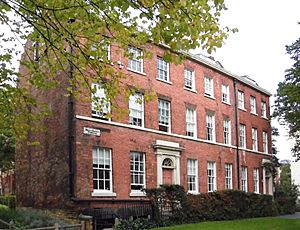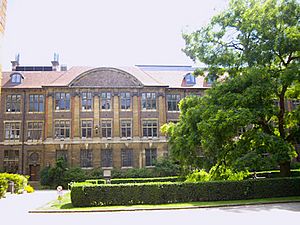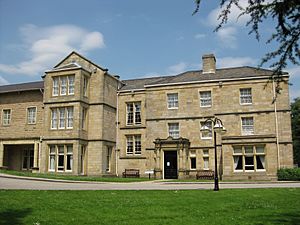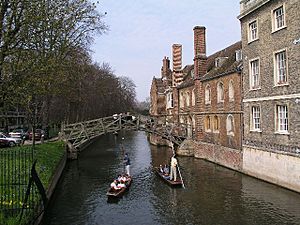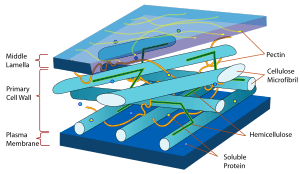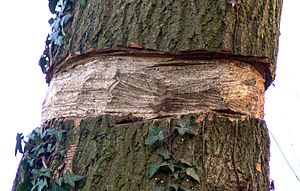Jane Ingham facts for kids
Quick facts for kids
Jane Ingham
|
|
|---|---|
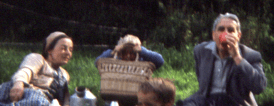
Ingham (left) with Albert Ingham (right) in 1966
|
|
| Born |
Rose Marie Tupper‑Carey
15 August 1897 Leeds, England
|
| Died | 10 September 1982 (aged 85) Cambridge, England
|
| Alma mater | University of Leeds (1928: MSc) |
| Spouse(s) | |
| Children | 2 |
| Relatives | Michael Sadleir (brother-in-law) |
| Scientific career | |
| Fields |
|
| Institutions |
|
| Thesis | Geotropism or Gravity and Growth (1928) |
| Academic advisors | Joseph Hubert Priestley |
Rose Marie "Jane" Ingham (born Tupper‑Carey; 15 August 1897 – 10 September 1982) was an English botanist and a scientific translator. She worked as a research assistant at the University of Leeds. There, she and Joseph Hubert Priestley were the first to separate cell walls from the root tip of broad beans. They discovered that these cell walls contained protein.
Jane Ingham also studied how cells in trees work when they change direction. She found big differences in how cells divide and grow in the outer layer of plants. Later, she joined the Imperial Bureau of Plant and Crop Genetics in Cambridge, England. She worked there as a scientific officer and translator. The bureau published journals about plant breeding and genetics. In 1932, she married Albert Ingham. During World War II, she lived in Princeton, New Jersey, with her two sons. She passed away in Cambridge in 1982.
Early Life and Family
Jane Ingham was born on 15 August 1897 in Leeds, England. She was the youngest daughter of Helen Mary Tupper‑Carey and Albert Darell. Her father, Albert Darell, was a Canon (a type of priest) in the Church of England. He was known as "Tupper" to his friends. People described him as a very friendly person who could easily talk to anyone.
Jane had four siblings. Her older sister, Jacqueline, became a missionary in the Far East. Another older sister, Edith (known as "Betty"), married the author Michael Sadleir. Her elder brother, Humphrey, was a tea planter in Africa. He later worked for the government in Nigeria. Her younger brother, Peter, was a captain in the Royal Navy.
Education and Early Interests
Jane went to Claire House School in Lowestoft, an all-girls school that focused on teaching French. When she was ten, she won a prize in a French exam. She even performed in a French play by Molière called Les Femmes Savantes. Her father, who was fluent in French, spoke to the audience after the play.
From a young age, Jane was interested in botany, the study of plants. She used to collect wildflowers for local shows. Her grandmother, Helen Jane Carey, was also a keen amateur botanist. Collecting plant specimens was a popular hobby in Victorian England.
In 1916, Jane began studying botany at the University of Leeds. By 1919, she was a research student, studying how plant roots absorb water. She also studied zoology at the Marine Biological Association in Plymouth.
Scientific Career
In January 1922, Jane Ingham became a research assistant in the botany department at the University of Leeds. She worked with Joseph Hubert Priestley, who was the Dean of Science. They made an important discovery: they were the first to separate cell walls from the growing tips (called meristems) of broad bean plants. They studied these cell walls and found that they contained protein.
They also researched when plants first produce cellulose, which is a key part of plant cell walls. They looked at how shoots and roots develop differently and the role of the cork cambium, which helps trees grow wider. These studies led to two scientific papers. Jane Ingham earned her Master of Science (MSc) degree in 1928 for her research.
In February 1930, Jane joined the Imperial Bureau of Plant and Crop Genetics in Cambridge. She worked there as a translator and scientific officer. She was very good at languages, speaking French, Italian, German, and Swedish. The bureau published summaries (called abstracts) of scientific papers from around the world. Many of these papers were in foreign languages, and Jane helped translate them. She even worked from home translating German documents after she got married.
Personal Life
Around 1922, a famous artist named William Roberts painted a portrait of Jane Ingham. The painting was called "Portrait of Miss Jane Tupper‑Carey."
By 1926, she became a sub-warden at Weetwood Hall, a university residence for women students at Leeds. In the same year, she helped start the Leeds branch of the British-Italian League. This group aimed to improve relations between Britain and Italy.
Jane also enjoyed acting. In the late 1920s, she joined the Leeds University Amateurs, a drama society. She performed in several plays.
Jane married Albert Ingham on 6 July 1932 in Cambridge. They had met when Albert was a professor of mathematics at the University of Leeds. Their engagement was a surprise to their friends because they had kept their relationship quiet.
In 1939, Albert received a research fellowship to study in Princeton, New Jersey, in the United States. Jane and their two sons, Michael Frank and Stephen Darell, sailed to New York with him. Just two days into their trip, Britain declared war on Germany. Because of the war, Jane decided to stay in Princeton with her children. Albert returned to England by 1942.
Later Life and Passing
The Inghams owned a small boat called Pete, which they used for trips and picnics on the River Cam in Cambridge. They also traveled a lot, visiting places like India and going on walking holidays in the French Alps. It was during one of these holidays that Albert passed away from a heart attack.
Jane Ingham was described as very energetic and fit. Her grandson, Dr. Mark Ingham, remembered how fast she used to walk. She passed away in Cambridge on 10 September 1982.
Scientific Discoveries
Protein in Plant Cell Walls
Jane Ingham and Joseph Hubert Priestley were the first to successfully separate cell walls from the growing tips of broad bean plants. They found that these cell walls contained a mix of protein and pectin. They suggested that these walls might start mostly as protein.
Later, other scientists found protein in plant cells. However, it was hard to be sure if it was part of the cell wall or just from the cell's inside (cytoplasm). Today, we know that the middle layer of plant cell walls, called the middle lamella, is rich in pectin. Scientists are still studying how this layer is built and how it works.
Cell Division and Growth in Plants
Jane Ingham also studied how cells divide and grow differently in the outer layers of plants. She looked at the stem of sunflower seedlings and found that the outer side of a curved stem had many more cells than the inner side. For example, she counted 3,299 cells on the upper (outer) side compared to 1,531 on the lower (inner) side.
This meant that the outer side of the curve grew more, not just by cells getting longer, but also by dividing more often. This showed that the inner and outer sides of a plant stem have very different ways of growing. This difference in growth can be caused by how a plant hormone called auxin is moved around the plant. Auxin helps cells get longer.
Importance of Cell Orientation in Cork
In one of her last studies at the University of Leeds, Jane Ingham experimented with Laburnum and sycamore trees. She removed a ring of bark from the trees, a process called ring-barking. However, she left small zigzag bridges of tissue connecting the bark above and below the cut.
She observed that the cells in these bridges changed. At first, they formed a mass of round cells. Later, some of these cells became long and stretched out horizontally, following the direction of the bridge. This showed that the cells in the tree's growing layer (cambium) might not work correctly if their orientation changes. Scientists think this could be due to changes in pressure, nutrient flow, or the movement of plant hormones.



